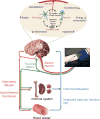Biological networks in ischemic tolerance - rethinking the approach to clinical conditioning
- PMID: 24223074
- PMCID: PMC3821776
- DOI: 10.1007/s12975-012-0244-z
Biological networks in ischemic tolerance - rethinking the approach to clinical conditioning
Abstract
The adaptive response (conditioning) to environmental stressors evokes evolutionarily conserved programs in uni- and multicellular organisms that result in increased fitness and resistance to stressor induced injury. Although the concept of conditioning has been around for a while, its translation into clinical therapies targeting neurovascular diseases has only recently begun. The slow pace of clinical adoption might be partially explained by our poor understanding of underpinning mechanisms and of the complex responses of the organism to the stressor. At the 2(nd) Translational Preconditioning Meeting participants engaged in an intense discussion addressing whether the time has come to more aggressively implement clinical conditioning protocols in the treatment of cerebrovascular diseases or whether it would be better to wait until preclinical data would help to minimize clinical empiricism. This review addresses the complex involvement of biological networks in establishing ischemic tolerance at the organism level using two clinically promising conditioning modalities, namely remote ischemic preconditioning, and per- or post-conditioning, as examples.
Conflict of interest statement
The authors declare that they have no conflict of interest
Figures

References
Publication types
MeSH terms
Grants and funding
LinkOut - more resources
Full Text Sources
Other Literature Sources

